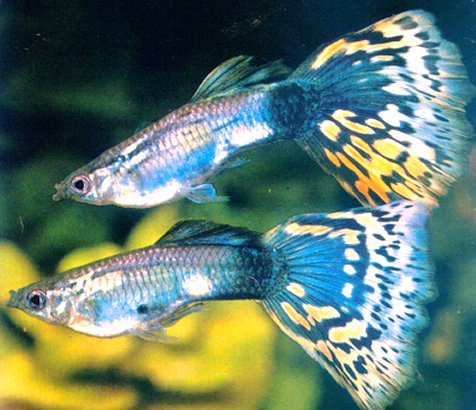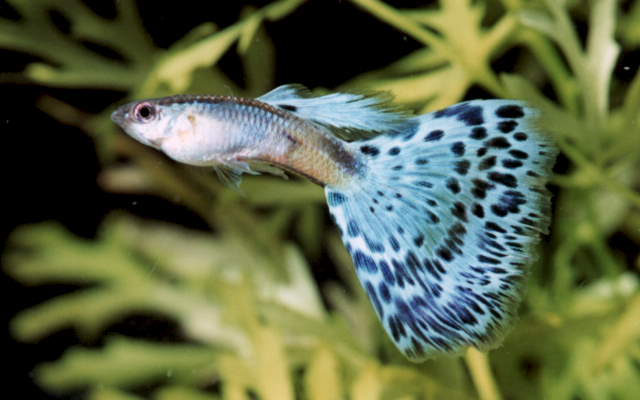BREEDING HIGH QUALITY GUPPIES
(By Nagarajan.V Feb-2001)





Guppies have always been the main attraction for any beginner and these small fishes come
in innumerous colours and fin shapes. It has always been a challenge to breed good quality guppies
that have identical fin sizes and shapes with good size. In this article I have described what expert
aquarists follow for breeding good quality guppies.
Often when you go to the LFS and buy a pair of guppies your first idea is to get some fry
from the female as soon as possible. Most often the female is kept together with the males in the same
tank and many males would have mated with the female before you bought it. The sperms stored in the
female probably belongs to many males some of them might not be of good quality but virile enough to
make the female pregnant. When you get the first litter you probably have a lot of bad quality fry
which grow up and again mate with each other and produce even worse quality fry. The quality degrades
with each generation and after some time you get fed up with guppies.
To avoid this the first thing you should do is to select quality specimens. Always look for
males that have good body shape and fin shape. The fin colour should be good and size large. In males
you must look for fin size, shape and colour. The caudal fin for quality guppies are either triangular
or delta shaped. The caudal fin should be broad and flowing. The dorsal fin should be flowing and
approximately the length of dorsal fin should be 3/4 the length of caudal fin. The dorsal fin should
have the same colour and pattern as the body and caudal fin, at least matching. The body colour and
pattern should match the caudal fin. Select males that are healthy and young. Do not choose ones that
show signs of age or hump backs. The female should be healthy and young. The female need not have any
colours. Preferably it should be as colourless as possible. Select two females and two males. Buy the
two pairs from different LFS so that they come from different parents and strains.
Now what I am going to describe is called line breeding method with cross breeding to
increase the quality of the genes. Let us see the difference between line breeding and cross breeding.
Suppose you have a female and male, they mate with each other and produce fry. The male and female among
the fry mature and mate with each other and produce more fry. This third generation again mate and
produce fry and so on. This is called Line breeding. In this there may be cases where the fry mates with
the parents and produce fry, this is called In-breeding. Cross breeding means you have two sets of males
and females, each producing fry. The male from one batch of fry mates with the female from another
batch of fry and produce young. This is called cross breeding. Means the parentage lines are crossed.
Both type of breeding have advantages and disadvantages.
Line breeding has some advantages that the genetic traits such as fin shapes, colours etc..
are improved by this method. The generations down the line have better fins and colours than the parents
and also the colours remain uniform for all the males. But if we do it a few generations then the
fish loose certain other genetic qualities such as resistance to disease etc..This is a big disadvantage.
In-breeding even improves the colours and shapes and you may probably get fish that look exactly
alike and difficult to tell apart.
Cross breeding has the advantage that it improves the fishes resistance but the colours
always get mixed up unless you have almost identical lines to cross. This does not improve the colours
or the size of fins. The fishes tend to become smaller and smaller down the line and after many generations
you may end up with a colourless native guppy which is extremely resistant to diseases and can
live even in drains as they do in India, where they are introduced to control mosquitoes. Your modern
show guppies cannot survive even a single day in those drains.
Now how do we tap these two techniques to our advantage. As I told you, you need two lines
of males and females which have almost identical fins and colours. They need to be kept in two different
tanks. In fact be ready to keep a series of tanks, may be 5 Gallons each. Plastic containers are
also enough. Professional breeders have had more than 40 tanks to keep a series of strains going.
Now allow the males and females to live in the two tanks separately. We will call them Line-A and Line-B.
Now discard the first three litters as they probably belong to other males. Females normally hold the
sperm in their body for at least three litter. That is why some times you have females giving birth
even a couple of months after the males have died. Either you can raise them separately and see if
you can get some quality fish of different colour which you might want to breed
or discard them in a suitable way. Do not dump them in the toilet.
Now allow the fourth litter fry to grow, keeping the Line-A and B in separate fry tanks.
During the growth, feed them with good quality flakes and live food. As they grow discard all those
that are smaller and do not grow fast. Keep only the best. As they reach about 1/2 inch size, you can
probably see which is male and female and separate them as soon as you can identify. Look for the
anal fin of males, which turns into gonopodium. Keeping males and females separate will ensure you
have virgin females for future breeding. Now already you have 8 tanks.
Once the fry have grown and matured, see if any males are better coloured and shaped than
their father. If so select the best of the lot. If not keep the father. Now from among the females
take the one that has the caudal fin with same colour shade as the male, say red or gray or blue and
allow it to mate with the best male of the Line-A. Keep both in a separate tank. Now raise the
fry of this generation separately. When they mature again separate the male and females and raise
them. Now select the best male from this Line again, this time most likely one of the fry would
be better than his father or grandfather. Choose the best male. Choose the best female or the mother
allow them to mate. Raise the fry and so on. Keep this line separately. You must label the tanks
with a label containing the generation number and also the Line name. Do not keep them nearby incase
they accidentally mix by jumping across to the next tank or you may accidentally mix up or so.
Do the same with a series of tanks for Line-B. After a few In-breeding and Line-breeding
you need not keep so many tanks. Just keep 4 tanks for each line, One for breeding pair, one for male
fry you want to use for future breeding, one for female fry you want to use for future breeding
and another for other fry which are not the best, but still can be sold.
After a few generations, cross the two lines, making sure that the two lines look identical
in terms of fin colours, shapes, body colours etc.. For crossing take the male of Line-A and breed with
a virgin female of Line-B and use the fry as Line-A stock for future Line breeding. Now take the best
male of Line-B and cross with the best virgin female of Line-A and use the fry as Line-B stock for
future Line breeding. This crossing tremendously improves the resistance of the fish genes, at the
same time keeping the colours and shape with out deformation. This crossing should be done only
once in four or five generations. Once you establish a Line you can keep breeding the same parents and
produce many generations of fry and sell them when they are adults. When the parents are about to get
old use a new pair of adult fry for breeding. Or if you find that some fry looks better than the parent,
use it for breeding. Avoid too much Line breeding as it quickly degrades the resistance of the fish.
Stop once you get a good set of parents and just raise and sell the fry of them for years. A word of
caution, always keep a back up of next generation adults incase you loose the parents due to some
disease or other reasons. You do not want to loose the Line that you have taken so long to develop.
If you have space and time you can keep a few strains and lines going. Best of luck. Always
feed the breeding pair with the best of food, varying in type. Feed live food at least on alternate days.
Keep the water quality at a high level. Ensure you have live plants in their tanks. You do not need
large tanks for the guppy breeding. 5 Gallon tank with box filter is enough for one pair. Never put
any other fish even if it is a cory cat in the same tank as breeding pair of guppies. Never keep
any fry or juveniles with the breeding pair. They have to be absolutely alone. Give the female at least
a weeks rest before you allow her to mate with the male again. This is just to avoid her being
harassed by the male. A glass partition would be of great help. Also a breeding trap which can hang
on the side of the tank.
Good Luck.
(Note: permission to copy is required)
(This article has been contributed by one of the users of this website. The webmaster does not own the
contents of this articles and is not responsible for the correctness of the contents. The user shall decide
if this is correct and if any information is wrong please write to the forum. Other articles on the same subject
are welcome and will be included in the same page with the authors name)